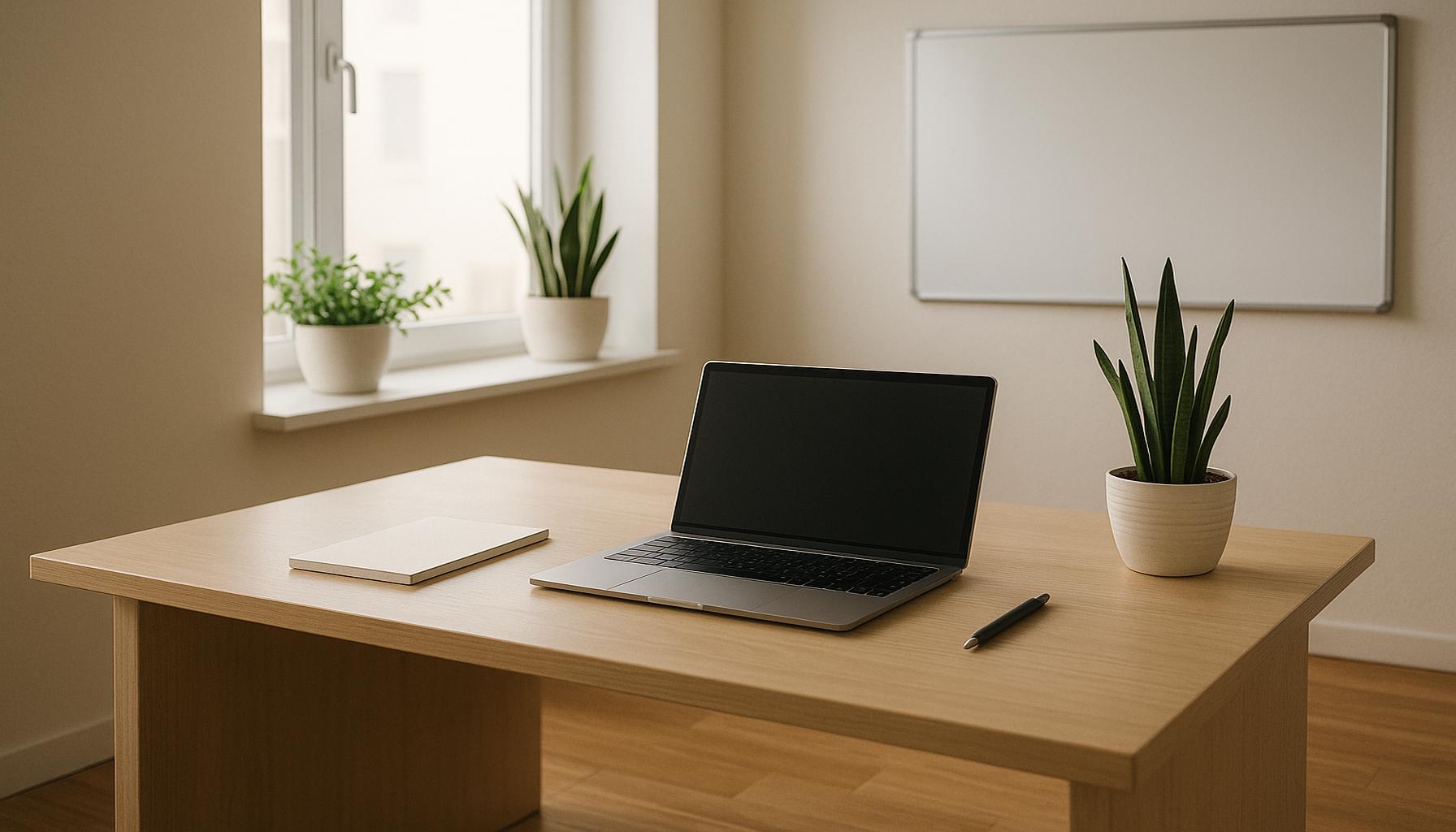Simplicity in the Workplace: How a Minimalist Organization Boosts Productivity

Understanding the Benefits of Minimalism in the Workplace
In today’s fast-paced business environment, simplicity in the workplace has emerged as a powerful strategy. Companies are discovering that a minimalist organization can significantly elevate productivity levels. By streamlining processes and reducing clutter, organizations can foster a more focused work culture that encourages not just efficiency, but also employee satisfaction.
Let’s delve deeper into the advantages of adopting a minimalist approach:
- Clarity of Purpose: A simplified workspace aids employees in concentrating on essential tasks. When the physical space is free from distractions, workers can prioritize their workflow, leading to improved output. For instance, a clear desk policy can empower employees by allowing them to focus solely on their current projects without the visual clutter of unfiled papers or unnecessary gadgets.
- Reduced Stress: A decluttered environment significantly lowers anxiety levels and distractions. Research indicates that visual chaos can contribute to cognitive overload. In a minimalist workspace, employees are likely to experience a calmer atmosphere. For example, tech companies like Basecamp have embraced the principles of minimalism to create a serene work environment, where employees can manage their workloads without overwhelming stress.
- Enhanced Creativity: Space can promote innovative thinking by minimizing visual chaos. When distractions are reduced, employees have the mental space to explore new ideas and solutions. A minimalist approach encourages brainstorming sessions that might yield groundbreaking concepts. Consider how companies like Airbnb have designed their offices to foster creativity, allowing for open spaces that encourage collaboration and imaginative thinking.
Supporting the claim that workspace organization directly correlates with performance metrics, a study conducted by the University of California revealed that employees in minimalistic environments are more effective in both task completion and decision-making. Additionally, research from Harvard Business Review indicates that minimalism can lead to improved collaboration among teams, fostering a culture where sharing ideas and feedback becomes frequent.
With influential companies such as Apple and Google leading the charge, the trend towards simplicity and minimalism is evident. These industry giants have carefully designed their work environments to reflect their minimalist philosophies, aiming not just for aesthetics but for functionality and productivity.
As businesses evolve, grasping how minimalism boosts productivity is becoming increasingly crucial. The transition to a minimalist organization requires continuous assessment and adaptation of strategies, especially in a rapidly changing landscape. By embracing this approach, organizations are setting themselves up for sustainable success while fostering an environment where creativity, efficiency, and employee satisfaction thrive.

DISCOVER MORE: Click here to delve deeper
Creating a Streamlined Workflow Through Minimalism
When organizations prioritize simplicity within their operations, they often find that a minimalist organization not only sharpens focus but also streamlines workflows. Here are some ways in which minimalism can transform workplace productivity:
- Efficient Communication: In an environment where clutter is minimized, communication can become more straightforward. A minimalist workplace encourages concise and clear interactions among team members. When distractions are reduced, employees are more likely to understand tasks and directives without ambiguity, resulting in fewer misunderstandings and mismanagement of resources.
- Optimized Resource Allocation: By adopting a minimalistic approach, organizations can better assess which resources are truly necessary. This often leads to a more effective use of both time and money. For instance, when processes are stripped back to their essentials, teams can focus on key projects that drive significant outcomes instead of spreading themselves thin across multiple initiatives.
- Flexible Adaption: A streamlined structure allows teams to shift priorities quickly in response to changing market needs. This agility is especially valuable in industries that are subject to rapid innovation or shifting consumer preferences. The ability to pivot without the burden of unnecessary processes can lead to increased competitiveness.
Research supports the advantages of a minimalist structure, with studies showing that organizations that maintain clarity in their processes witness improved employee performance. A recent report from Gallup highlighted that teams with cohesive and uncomplicated workflows exhibit higher engagement levels, translating directly to enhanced productivity.
Furthermore, embracing technology that complements a minimalist approach can provide significant advantages. Tools that facilitate collaboration without adding complexity—like project management software designed for simplicity—can empower teams to work more efficiently. By utilizing intuitive systems, employees can easily track progress and communicate about projects without becoming overwhelmed by technological hurdles.
The implications of minimalism extend beyond merely the physical workspace—the essence of simplicity can also be incorporated into digital environments. For example, companies can benefit from streamlined digital communication platforms that minimize noise and promote focused discussions. The goal is to cultivate an atmosphere conducive to innovation and sustained productivity, propelling the organization forward.
As leaders explore the best practices for fostering a minimalist workplace, a thoughtful evaluation of existing processes is paramount. Organizations should continually assess which tools and strategies truly contribute to their overall efficiency and productivity, discarding those that detract from their focus. This ongoing commitment to simplicity is key to sustainable growth in an ever-evolving business landscape.
| Advantage | Details |
|---|---|
| Enhanced Focus | A minimalist workspace minimizes distractions, allowing employees to concentrate on critical tasks. |
| Improved Efficiency | Streamlining processes and reducing clutter facilitates faster decision-making and task execution. |
Minimizing clutter in the workplace plays a crucial role in enhancing overall productivity. By creating a space that prioritizes essential tools and resources, employees find it easier to focus on their tasks. The act of decluttering not only clears physical space but also promotes mental clarity. Furthermore, in a minimalistic environment, employees can experience heightened efficiency as processes are streamlined. This eliminates the time wasted in searching for items or navigating through unnecessary materials, subsequently enhancing workflow.Exploring various strategies for implementing minimalism can lead to new insights into workplace organization. Consider techniques like the 5S methodology, which emphasizes Sort, Set in order, Shine, Standardize, and Sustain. By integrating such principles, organizations can cultivate a culture of simplicity that ultimately boosts productivity. As companies continue to shift towards efficiency-driven models, understanding the profound impact of a minimalist organization will be essential in reaping the benefits of today’s fast-paced work environment.
DIVE DEEPER: Click here to discover more about embracing simplicity
Enhancing Employee Well-being Through Minimalism
Beyond just optimizing workflows, embracing a minimalist organization can substantially enhance employee well-being, fostering a healthier work environment. A workplace designed with minimalism in mind helps reduce stress and enhances job satisfaction, ultimately translating into higher productivity levels. Consider the following aspects:
- Reduced Overwhelm: In offices flooded with unnecessary materials, overwhelming visuals can lead to cognitive overload, resulting in decreased focus and productivity. A minimalist approach simplifies the physical workspace, allowing employees to concentrate on the tasks that matter most. In fact, studies have indicated that workplaces where clutter is kept to a minimum tend to produce happier employees. When distractions are limited, individuals are able to manage their time better, making them less likely to feel rushed or stressed.
- Promotion of Mindfulness: Minimalism encourages a mindful approach to work, prompting employees to engage fully in their tasks rather than multitasking or dividing their attention. Mindfulness has been linked to improved mental clarity and productivity. An environment where distractions are fewer allows employees to devote their attention to their work, enhancing cognitive function and driving performance.
- Encouragement of Collaboration: A minimalist layout encourages open spaces that facilitate collaboration among team members. By promoting shared areas with fewer barriers, employees can easily share ideas and engage in dialogue, fostering camaraderie and innovation. For example, tech companies like Google have adopted minimalist designs in their offices, emphasizing open layouts that support teamwork and creativity.
Data supports the notion that simplifying one’s workspace and reducing noise can lead to improved morale. A report from Britain’s Office for National Statistics noted that employees who operate in clean and organized environments felt less afraid of failure and were more motivated to perform their roles effectively. These attitudes further bolster their sense of ownership over their work, fueling a cycle of increased productivity.
Furthermore, a minimalist organization can contribute to work-life balance. By clarifying responsibilities and streamlining processes, employees can better manage their time, leading to fewer hours spent on unnecessary tasks and, subsequently, fewer instances of burnout. A balance between work and personal life has been shown to enhance overall job satisfaction, which correlates directly with improved workplace morale and productivity.
In addition to physical changes, integrating minimalist philosophies into company culture can manifest as adopting clear objectives, streamlined communication channels, and a focus on essential performance metrics. By prioritizing what truly drives value, organizations can eliminate redundancy in both processes and communication, leading to less frustration among employees.
As companies evaluate the implementation of minimalist practices, it is essential to train employees not just in the tactical aspects of minimalism, but also in understanding its foundational philosophies. Workshops on decluttering both physically and mentally can empower teams, fostering a culture where simplicity and focus become intrinsic values. This leads to a naturally productive atmosphere where innovation thrives.
DISCOVER MORE: Click here for insights on embracing simplicity
Conclusion: Embracing Minimalism for a Productive Future
In a world where complexity increasingly seeps into our professional lives, the reinvention of the workplace through minimalist organization presents not only a breath of fresh air but a powerful strategy for enhancing productivity. By prioritizing simplicity, organizations can create environments that reduce cognitive overload, promote mindfulness, and encourage collaboration among teams. The poignant truth is that less can be more; a streamlined workspace fosters clarity of thought and allows employees to focus on what truly matters.
As highlighted, implementing minimalism can lead to notable increases in employee well-being, directly correlating to higher job satisfaction and reduced stress. Companies that embrace it witness a transformational shift in their corporate culture, wherein clearer communication and streamlined processes remove redundancy and chaos. The proliferation of open spaces and organized environments can cultivate a sense of community, encouraging creative exchanges that propel innovation forward.
Moving forward, businesses across the United States must recognize the tangible benefits of adopting minimalist principles. From time management enhancements to improved morale, the advantages are clear. Organizations are encouraged to invest in both the physical and philosophical aspects of minimalism, equipping teams with tools and training that promote simplicity as a foundational value. This not only leads to sustained productivity but also ensures that employees can perform at their best, unencumbered by distractions.
In conclusion, the journey toward a minimalist workplace is not merely about decluttering desks; it is about rethinking the way we approach work. By committing to a minimalist philosophy, organizations can not only boost productivity but pave the way for a healthier, more vibrant workplace culture ready to take on the challenges of tomorrow.


